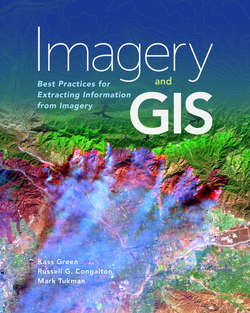Читать книгу Imagery and GIS - Kass Green - Страница 67
На сайте Литреса книга снята с продажи.
What are the requirements for spatial and spectral accuracy?
ОглавлениеAll imagery used to make a map or measure distances on the landscape needs to be registered to the ground and have the effect of terrain displacement removed (see chapter 6 for more detail on these topics). While once a cumbersome and difficult task, georeferencing and terrain correction have become much easier with the development of worldwide digital elevation models, control points, and image matching algorithms. However, not all remote sensing systems have the same quality of instrumentation, and not all remote sensing companies have the same quality of processing systems, access to high-quality digital elevation models, existing accurate orthoimagery, or ground control points. Additionally, many remote sensing companies sell products with different levels of spatial accuracy.
When acquiring imagery, the analyst should always understand its stated spatial accuracy, which is usually expressed as the maximum circular error in meters at a 90 percent confidence level—termed “CE90” (see chapter 12 for a detailed discussion of how spatial accuracy is determined). Additionally, the accuracy of the imagery should be checked against ground control points or a GIS dataset known to be more accurate than the imagery. It is not unusual for spatial accuracies to be less than stated, especially in areas with little ground control or of high terrain relief. Additionally, spatial accuracy is also affected by the viewing angle of the collection. Usually, the more off-nadir the collection, the lower the spatial accuracy.
Equally important but less frequently discussed is the spectral accuracy of the sensor—do the sensor’s measured data recordings match its expected data recordings? Atmospheric interference, sensor defects, system noise, and variations in scan angle can result in a device recording data for an object that is different from the true spectral reflectance or emission of the object. There are two important questions to ask regarding a sensor’s spectral accuracy. First, is the sensor regularly tested to determine whether it records data precisely and accurately? Second, does the sensor operator either calibrate their imagery to correct for sensor errors or provide calibration statistics and algorithms so that the user can correct for errors?
For example, the spectral accuracy of Landsat data is continually tested using preflight, postlaunch-onboard, and ground reference data. USGS also provides calibration parameter files of geometric and radiometric coefficients needed for correcting raw Landsat image data. The calibration of Landsat imagery is considered the gold standard and is so good that other satellite image providers often calibrate their imagery against Landsat imagery rather than collecting their own ground reference data. Most, but not all, sensor operators include some metadata with their image data, which can support calibration. Calibrating imagery is a common preprocessing step that is discussed in more detail in chapter 6.
